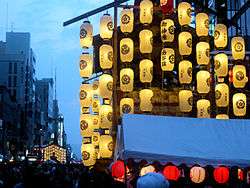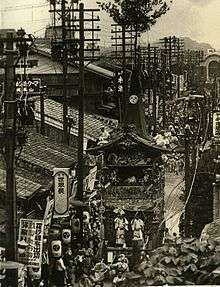Gion Matsuri
| Gion Matsuri | |
|---|---|
 "Yoiyama" | |
| Observed by | Kyoto |
| Type | Religious |
| Begins | 1 July |
| Ends | 31 July |
| Date | Month of July |
The Gion Festival (祇園祭 Gion Matsuri) takes place annually in Kyoto and is one of the most famous festivals in Japan. It lasts for the entire month of July and culminates in a parade, the Yamaboko Junkō (山鉾巡行) on July 17 and July 24. It takes its name from the Gion district of the city.
Kyoto's downtown area is reserved for pedestrian traffic on the three nights leading up to the massive parade. These nights are known as yoiyama (宵山) on July 16 and July 23, yoiyoiyama (宵々山) on July 15 and July 22, and yoiyoiyoiyama (宵々々山) on July 14 and July 21. The streets are lined with night stalls selling food such as yakitori (barbecued chicken on skewers), taiyaki, takoyaki, okonomiyaki, traditional Japanese sweets, and many other culinary delights. Women dressed in yukata (summer kimono) walk around the area, carrying with them traditional purses and paper fans.
During the yoiyama evenings leading up to the parade, some private houses in the old kimono merchant district open their entryways to the public, exhibiting family heirlooms in a custom known as the Byōbu Matsuri, or Folding Screen Festival. This provides visitors with an opportunity to visit and observe traditional Japanese residences.
History
Ancient years


This festival originated as part of a purification ritual (goryo-e) to appease the gods thought to cause fire, floods and earthquakes. In 869, when people were suffering from a plague attributed to the rampaging deity Gozu Tennō (牛頭天王), Emperor Seiwa ordered prayers to the god of the Yasaka Shrine, Susanoo-no-Mikoto. Sixty-six stylized and decorated halberds, one for each of the traditional provinces of Japan, were prepared and erected at Shinsen-en, a garden, along with portable shrines (mikoshi) from Yasaka Shrine. This practice was repeated wherever an outbreak of plague occurred. In 970, the festival became an annual event and it has since seldom failed to take place. In 1533, the Ashikaga shogunate halted all religious events associated with the festival. Over time the increasingly powerful and influential merchant class made the festival more elaborate and, by the Edo period (1603–1868), it was using the parade to brandish its wealth.
Smaller floats lost or damaged over the centuries have been restored, and the weavers of the Nishijin area offer new tapestries to replace destroyed ones. When they are not in use, the floats and regalia are kept in special storehouses throughout the central merchant district of Kyoto.
The festival serves as an important setting in Yasunari Kawabata's novel, The Old Capital in which he describes the festival, along with the Festival of Ages and the Aoi Festival, as "the 'three great festivals' of the old capital".[1]
Gallery
 Ayagasaboko float
Ayagasaboko float Police stand ready.
Police stand ready. Food and crafts adorn every street during the festival.
Food and crafts adorn every street during the festival. A yamaboko float, 2013.
A yamaboko float, 2013.






Schedule of events
Following is a list of selected annual events in the Gion Festival.
- July 1 through 5: Kippuiri, opening ceremony of festival in each participating neighbourhood
- July 2: Kujitorishiki, lottery for the order of floats in the parade order, conducted at the municipal assembly hall
- July 7: Shrine visit by chigo children of Ayagasaboko
- July 10: Lantern parade to welcome mikoshi (portable shrines)
- July 10: Mikoshi arai, cleansing of mikoshi with sacred water from the Kamo River
- July 10 through 13: Building of floats
- July 13 a.m.: Shrine visit by chigo children of Naginataboko
- July 13 p.m.: Shrine visit by chigo children of Kuse Shrine
- July 14: Yoiyoiyoiyama
- July 15: Yoiyoiyama
- July 16: Yoiyama
- July 16: Yoimiya shinshin hono shinji, art performances
- July 17: Parade of yamaboko floats
- July 17: Parade of mikoshi from Yasaka Shrine
- July 18 through 20: Building of floats
- July 21: Yoiyoiyoiyama
- July 22: Yoiyoiyama
- July 23: Yoiyama
- July 24: Parade of yamaboko floats
- July 24: Parade of hanagasa ("flower parasols")
- July 24: Parade of mikoshi to Yasaka Shrine
- July 28: Mikoshi arai, cleansing of mikoshi with sacred water from the Kamo River
- July 31: Closing service at Eki Shrine
Yamaboko floats

The floats in the Yoiyama Parade are divided into two groups, the larger Hoko ("halberd") and the smaller Yama ("mountain"), and are collectively called Yamaboko (or Yamahoko). The nine Hoko represent the 66 halberds or spears used in the original purification ritual, and the 23 Yama carry life-sized figures of famous people. All the floats are decorated with tapestries, some made in Nishijin.the textile district of Kyoto, others imported from all over the world. Traditional musicians and artists sit in the floats. In 2009 Yamahoko was listed on the Representative List of the Intangible Cultural Heritage of Humanity.
Each year the families that maintain the floats draw lots at a special meeting to determine in what order they will take part in the festival. These lots are issued at a special ceremony before the parade, during which the Mayor of Kyoto dons the robes of a magistrate. On the Naginata Hoko is the chigo, a young boy in Shinto robes and crowned with a golden phoenix, chosen from among the Kyoto merchant families as the deity's sacred page. After weeks of special purification ceremonies, during which he lives isolated from contaminating influences such as the presence of women, he is carried onto the float, as he is not permitted to touch the ground. The boy must cut a sacred rope (shimenawa) with a single stroke to begin the festival.
Hoko floats
- Weight: about 12,000 kg
- Height: about 25 m from ground to tip / 8 m from ground to roof
- Wheel diameter: about 1.9 m
- Attendants: about 30–40 pulling during procession, usually two men piloting with wedges
Yama floats
- Weight: 1,200–1,600 kg
- Height: about 6 m
- Attendants: 14–24 people to pull, push or carry
Notes
- ↑ Kawabata, Yasunari. The Old Capital. Trans. J. Martin Holman. San Francisco: North Point Press, 1987. 131. Print
External links
| Wikimedia Commons has media related to Gion Matsuri. |